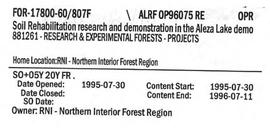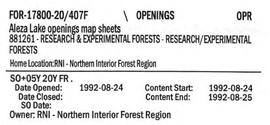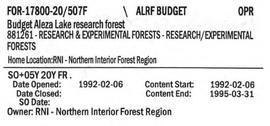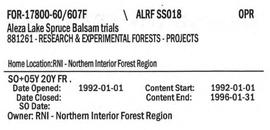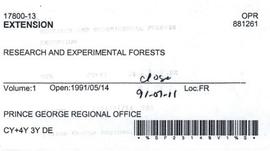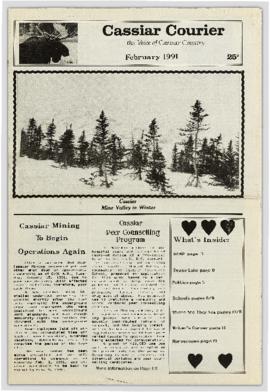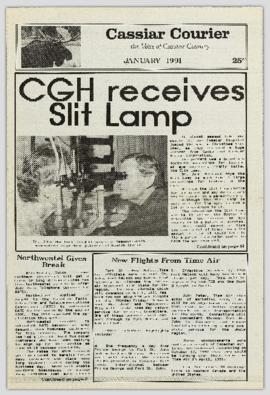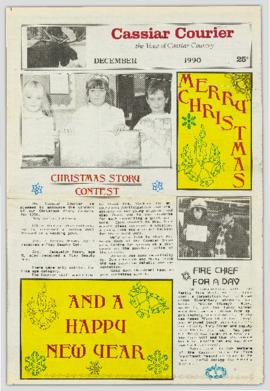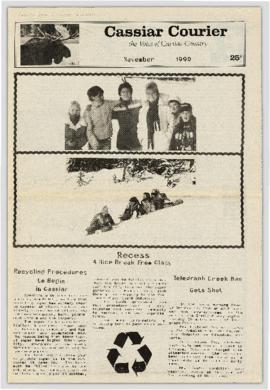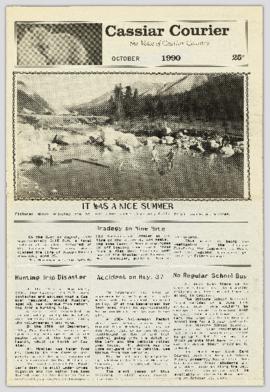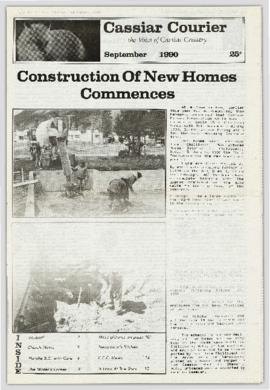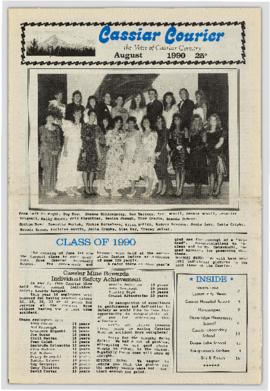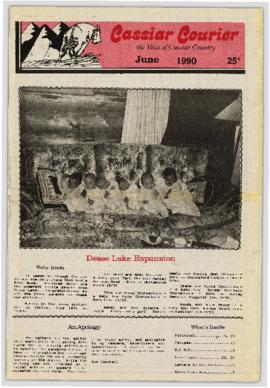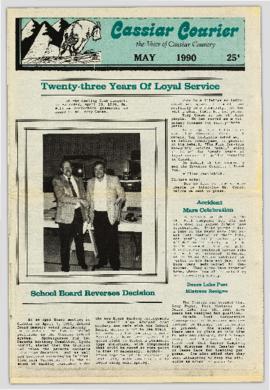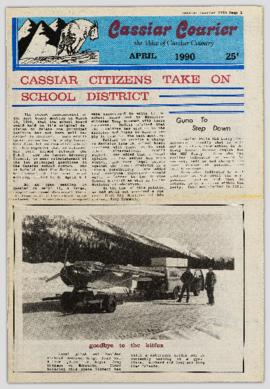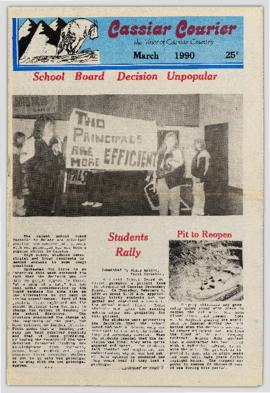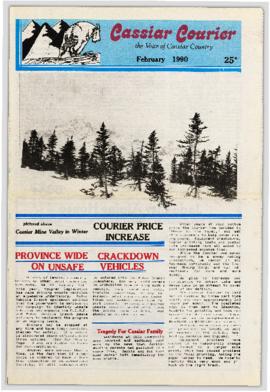File contains overview diagrams of Northwood cutting permits inside the Aleza Lake Research Forest, cutblocks showing harvesting and silvicultural history, detailed activity reports by cutblock, and 1992 Northwood cost summaries.
File contains Aleza Lake Experiment Station Climate Station data from 1952 to 1980 and three accompanying floppies with weather data and Fortran programs.
Item is "Cluculz Lake Silviculture Demonstration Area Trail Guide" by the BC Ministry of Forests.
File contains original and photocopied drafts of working plans and drafts, planning projects, original amendments to special use permits, handwritten notes, related correspondence, and photocopied maps.
File consists of a speech given by Gary Runka entitled "The Importance of Agriculture to BC and the Creston Valley" Creston Valley Agricultural Society.
Commentary on this speech by Barry Smith of the Ministry of Agriculture and Lands:
"The speech begins with a number of recent urban newspaper headlines illustrating the level of awareness and the stress on agriculture.
The paper is broken into several major topics:
(I) The Options - in which two perspectives are outlined - one positive that agriculture has social value and is vitally important to the province and second, that agriculture is ultimately doomed.
(II) The Agricultural Land (Water) Base - 11 different land use planning issues are reviewed from an agricultural perspective. It is stressed that agriculture must become a more integrated part of the overall planning process.
(III) The Economic and Social Well Being of the Farming Community. It is noted that there are strong feelings in rural communities that government bureaucrats impose planning and resource management decisions on them rather than plan with or for them. Thus, if agriculture is to thrive it must, once again, become a more integrated part of the overall planning process and the agricultural land base must be assured.
(IV) The Ecological and Economic Sustainability of Agriculture - A key agricultural land conservation measure will be the redirection of regional and local urban growth to available and suitable lands outside the ALR. Provincial and local zoning is seen as a first step framework for managing competition for agricultural land.
Betterment Recapture - this (possibly Henry George inspired) comment reflects the need to recapture a portion of the appreciated value when agricultural land is converted to urban uses as a hedge against speculative forces.
The paper ends by encouraging farm areas like the Creston Valley to take pride in their agricultural community because the opportunity exists for a vibrant, healthy sustainable future."
File consists of a speech given by Gary Runka entitled "Agriculture in the Urban Shadow" at the Agricultural Land Commission Symposium - Urban Growth and the Agricultural Land Reserve: 'Up not Out' - March 9,1993.
Commentary on this speech by Barry Smith of the Ministry of Agriculture and Lands:
"This represents an important, highly pertinent speech concerning farmland preservation in B.C. The speech was given at the ALC Symposium marking the 20th anniversary of B.C.'s farmland preservation program. The speech rings as relevant today as it did when delivered 22 years ago.
It begins by identifying two perspectives - one, those committed to an agricultural future, contributing diversity and having a social value and two, those that feel agriculture is ultimately doomed and is only an interim use, especially in the urban shadow, until a "higher and better" use comes along. GGR states that we need to honestly state which perspective we are guided by.
There are a host of important themes woven through this paper including:
- While farming on the urban shadow benefits both the urban and farm communities, the negative impacts of urban/farm adjacency are predominantly borne by the agricultural community.
- In describing the situation prior to the farmland preservation legislation in the 1960's and early 1970's agriculture was consistently the "loser user".
- Even in the earliest days of the Commission, urban shadow issues were identified and the ALC recognized that provincial zoning was only a first step, and taken alone, was not enough.
- The BC farmland preservation program has been at least as successful as anywhere else in North American and looked on with envy in many other jurisdictions.
- GGR believes that after 20 years we are worse off today than when the program started due to (i) elected provincial politicians involved with the application process (ii) the ALR / Golf Course fiasco and (ill) the ALC has become paralyzed in their Appeal Board mode.
Several (13 starting on p. 7) urban shadow issues are outlined and GGR states that we must be serious about addressing urban shadow issues.
The paper ends with an outline of "where we need to be tomorrow" and GGR states: "I recall when the program began in 1973 we argued that all of the compromises with respect to agriculture had already been made, if we were to keep the options open for future
generations In British Columbia. If that statement was true then, how much more true is it today, 20 years later?"
From the Symposium concluding remarks, Gary Runka stated that based on his experience and discussions during the symposium, he believed that the following initiatives should be given priority:
- Information and education programs
- Communication between farmers, government and the public
- Regional land use planning
- Integration of government policies to a strong farmland preservation strategy
- Provincial agricultural strategy
- Programs which insure farms can be viable
The Symposium proceedings have been compiled in a 67 page ALC publication."
While at the Ministry of Forests, Dr. Paul Sanborn carried out two retrospective studies which examined soil chemical properties at long-term silvicultural research sites where different vegetation types had been created, either as planned or unplanned experiments. These studies were Experimental Project (EP) 660 and a research project at the Archie Creek site.
This document is an undated 1990s handout for a field trip to the Archie Road (North) demonstration plot.
Item is an original "The North Ridge Eco-Trail Guide: Aleza Lake Research Forest" booklet.
Item is a reproduction of a report entitled "Burns Bog Analysis" by Catherine Berris & Associates for the Ministry of Environment, Lands & Parks. The scope of this Burns Bog Analysis was inventory and preliminary analysis; the process included information collection and review, preliminary analysis of existing and potential land uses and a public open house.
File consists of climate station data printed from computer disks, original and photocopied soil description forms, and original copies of ecological and terrain mapping reports.
File contains correspondence regarding funding for research project and computer generated maps.
Item is "The North Ridge Eco-Trail Guide: Aleza Lake Research Forest".
File contains 1991 regeneration data of permanent sample plots and a 1992 work term study report on the significance of the basal area on regeneration factors.
File contains map sheets with information relating to the historical recording of information concerning silvicultural treatments carried out on specific areas of land. This includes records concerning changes in the forest cover, changes in prescriptions, cut boundaries, changes in site prescriptions, original copies of silviculture prescriptions, and site plans.
File consists of budget proposals and forecasts for 1993/94 and 1994/95 with recommendations of road maintenance as the central expenditure.
File contains proposal updates and project expenditure lists.
File contains pre-harvest silviculture prescription reports and related correspondence between the Ministry of Forests, the Prince George Forest Region, and Northwood Pulp and Timber Limited.
File consists of a speech given by Gary Runka entitled "Working Together Towards Identifying and Protecting Land for Nature in the Kamloops Area" to an unknown audience.
File contains drafts of management and working plan for the period of 1992 to 2002, the final draft for the management and working plan, and related correspondence between Mike Jull and those involved with the Aleza Lake Research Forest.
File contains reports on the analysis of permanent sample plots in the Aleza Lake Research Forest.
File contains handwritten journal lists of remeasured permanent sample plots and charts of remeasured permanent sample plots.
File contains orginal and photocopied correspondence relating to silviculture field courses and graphs pertaining to volume and diameter changes.
File contains a 1997 field tour guide of the Aleza Lake Research Forest, and 1997 and 1998 government publications on research projects conducted at the forest.
"The Cassiar Courier" is a newspaper that documents the community and work life of the residents of Cassiar BC. Content includes text and photographs, as well as jokes, comics, and games.
File contains handwritten notes and a handwritten memorandum.
Item is a computer print-out of PSP data from Aleza Lake Research Forest.
File contains typed file notes and charts of remeasured experimental plots, as well as a floppy disk
File consists of an untitled published piece in Country Life Column by Gary Runka.
Commentary by Barry Smith of the Ministry of Agriculture and Lands:
"This article focuses a report of the B.C. Round Table on the Environment and the Economy - "A Better Way - Creating a Sustainable Development Strategy for B.C." published in 1990. The thrust of the article concerns the disregard for agriculture in the report. The report identifies six key principles which amount to reasonable objectives / goals but in contrast agriculture fares badly in the report. Three examples are provided of the report's failings with respect to agriculture. Four key questions are asked including, "How can we best protect the limited high capability agricultural land base from alternate use competition?"
File consists of a speech given by Gary Runka entitled "Agricultural Land and Its Management".
Commentary by Barry Smith of the Ministry of Agriculture and Lands:
"This paper has no indication of the audience or date but given that there are several references to 1990 reports, it probably dates to 1991.
Although the scope of this paper is national in several aspects, its primary focus is on the B.C. farmland preservation efforts.
Comment is made on the question of farmland being regarded as a 'commodity' vs 'scarce resource'. GGR draws upon a theme found in other speeches and papers when he notes that 'To some degree, the call for a new "foodland ethic" is based upon the belief that public policy should more adequately take into account the social value of foodlands, quite apart from the dollar value...."
The paper is broken into several sections:
(A) The Setting;
(B) Agricultural Land Loss, (which includes some excellent statistics - p. 2-3)
(C) Some Agricultural Management Issues,
(D) Action Response (this section briefly reviews farmland preservation efforts in each province with a particular emphasis on B.C. p. 5-6),
(E) The Future.
GGR lists the following action steps that BC should pursue:
- Repeal ALC Act appeals to Cabinet;
- Rescind the outright golf course use within the ALR; and
- Introduce Soil Conservation Legislation"
The Lost Chicken Mine, a placer gold mine in eastern Alaska, approximately 120 km west of Dawson City, Yukon, is an important fossil locality for the late Pliocene (approximately 2.5 – 3.0 million years ago). A comprehensive account of the stratigraphy and paleontology of this site was given by:
Matthews, J.V., Jr., J.A. Westgate, L. Ovenden, L.D. Carter, and T. Fouch. 2003. Stratigraphy, fossils, and age of sediments at the upper pit of the Lost Chicken gold mine: new information on the late Pliocene environment of east central Alaska. Quaternary Research 60: 9-18. https://doi.org/10.1016/S0033-5894(03)00087-5
Dr. Paul Sanborn visited the site on July 20, 2004, as part of a group led by Duane Froese (Professor, University of Alberta). The group concentrated on a single exposure (~ 2 m thick) straddling the Lost Chicken tephra, a volcanic ash bed (2.9 ± 0.4 myr) which is a major stratigraphic marker at the site. Sanborn described, photographed, and sampled this exposure, and obtained a basic set of characterization data. Intact samples were collected but thin sections were never produced.
Item is a photocopied "Report on Mt. Edziza, Tatlatui, Spatsizi" by Bob Henderson.
"The Cassiar Courier" is a newspaper that documents the community and work life of the residents of Cassiar BC. Content includes text and photographs, as well as jokes, comics, and games.
"The Cassiar Courier" is a newspaper that documents the community and work life of the residents of Cassiar BC. Content includes text and photographs, as well as jokes, comics, and games.
"The Cassiar Courier" is a newspaper that documents the community and work life of the residents of Cassiar BC. Content includes text and photographs, as well as jokes, comics, and games.
"The Cassiar Courier" is a newspaper that documents the community and work life of the residents of Cassiar BC. Content includes text and photographs, as well as jokes, comics, and games.
"The Cassiar Courier" is a newspaper that documents the community and work life of the residents of Cassiar BC. Content includes text and photographs, as well as jokes, comics, and games.
File contains proposals and recommendations, and first and final drafts of 5 year working and management plans for 1991.
"The Cassiar Courier" is a newspaper that documents the community and work life of the residents of Cassiar BC. Content includes text and photographs, as well as jokes, comics, and games.
"The Cassiar Courier" is a newspaper that documents the community and work life of the residents of Cassiar BC. Content includes text and photographs, as well as jokes, comics, and games.
File contains correspondence regarding logging in the Aleza Lake Research Forest from the Ministry of Forests.
"The Cassiar Courier" is a newspaper that documents the community and work life of the residents of Cassiar BC. Content includes text and photographs, as well as jokes, comics, and games.
File consists of working copies of aerial photos, vegetation tables printed from computer disk, photocopies of plot sheets, and lists identifying species.
Item is a document written by Dave Coopersmith entitled "The Aleza Lake Research Forest Reexamination of Past Experimental Studies".
File contains an original informational brochure on ecological reserves in British Columbia and correspondence relating to the transfer of the Aleza Lake Research Forest to a university research forest.
"The Cassiar Courier" is a newspaper that documents the community and work life of the residents of Cassiar BC. Content includes text and photographs, as well as jokes, comics, and games.
"The Cassiar Courier" is a newspaper that documents the community and work life of the residents of Cassiar BC. Content includes text and photographs, as well as jokes, comics, and games.
"The Cassiar Courier" is a newspaper that documents the community and work life of the residents of Cassiar BC. Content includes text and photographs, as well as jokes, comics, and games.
